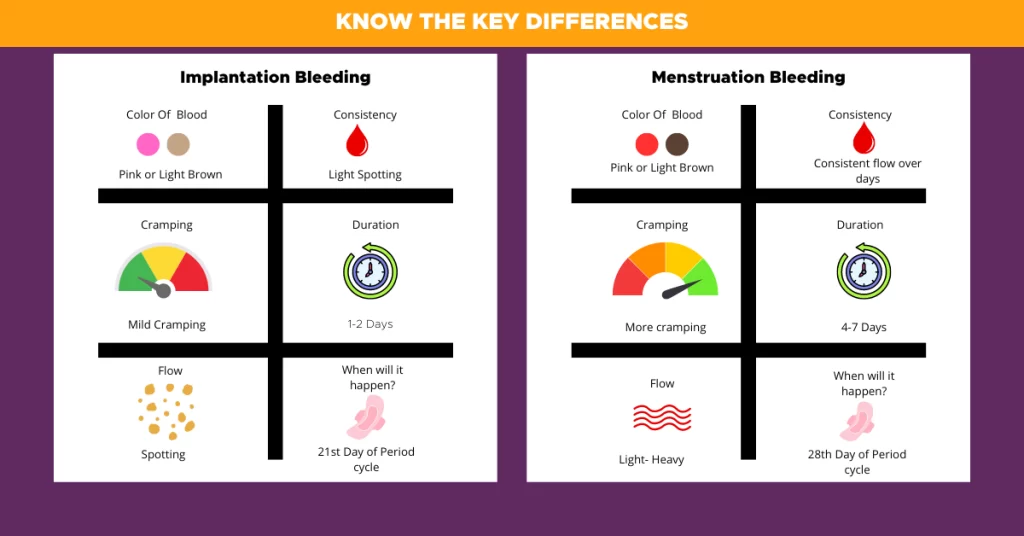Demystifying Implantation Bleeding – The Miracle Unveiled
Demystifying Implantation Bleeding – The Miracle Unveiled
Introduction
Implantation bleeding, a subtle yet crucial indicator of early pregnancy, introduces expectant parents to a world of anticipation and curiosity. As you embark on the awe-inspiring journey of parenthood, understanding the nuances of implantation bleeding becomes paramount. This phenomenon, often shrouded in mystery, serves as a vital signpost in the initial stages of pregnancy.
In this concise guide, we unravel the intricacies surrounding implantation bleeding, offering clarity on its nature and significance. From decoding the science behind this occurrence to exploring potential variations, we aim to equip you with essential knowledge. Join us as we navigate the subtle realms of implantation bleeding, empowering you to embrace the early stages of pregnancy with confidence and understanding.
What Is Implantation Bleeding?
Implantation bleeding is a subtle and common occurrence during early pregnancy. Typically experienced around 6 to 12 days after conception, it results from the embryo attaching itself to the uterine lining. Unlike menstrual bleeding, implantation bleeding is usually lighter and shorter, often manifesting as light spotting. This natural process signifies the successful implantation of the fertilized egg, and while not all pregnancies exhibit this symptom, understanding its characteristics can offer reassurance to expectant parents. In our blog, we delve deeper into the nuances of implantation bleeding, unraveling its significance in the early stages of pregnancy.
How Soon Does Implantation Bleeding Occur?
Implantation bleeding typically occurs 6 to 12 days after fertilization when the embryo embeds itself into the uterine lining. This narrow timeframe aligns with the early stages of pregnancy, providing a subtle yet significant sign for expectant parents. Recognizing the occurrence of implantation bleeding within this window can offer valuable insights, aiding in the understanding of the delicate processes unfolding during the initial weeks of gestation. In our comprehensive guide, we delve into the timing and significance of implantation bleeding, empowering you with knowledge for the exciting journey of early pregnancy.
How common is it?
Implantation bleeding is a relatively common occurrence during early pregnancy, experienced by a significant number of expectant mothers. While not every woman may notice or experience this phenomenon, studies suggest that around 20–30% of pregnant individuals may encounter implantation bleeding. Its prevalence underscores the diversity of experiences during the early stages of gestation. In our guide on implantation bleeding, we explore the commonality of this occurrence, shed light on its frequency, and offer insights into the various factors that may influence its manifestation during the exciting journey of pregnancy.
How Much Do You Bleed Implantation?
Implantation bleeding is characterized by its light and scant nature. Unlike a typical menstrual flow, the bleeding associated with implantation is often minimal, with many women experiencing only light spotting. This subtle discharge can vary in color, usually appearing as light pink or brown, and typically lasts for a short duration—ranging from a few hours to a couple of days. The limited amount of blood during implantation is a key distinction from regular menstruation, emphasizing this early pregnancy sign’s nuanced and delicate nature. In our comprehensive guide, we delve into the specifics of implantation bleeding, offering clarity on what to expect during this unique phase of early pregnancy.
Why does implantation bleeding happen?
Implantation bleeding occurs as a result of the fertilized egg making its home in the uterine lining. This delicate process involves the embryo burrowing into the endometrium, causing tiny blood vessels to rupture. The release of a small amount of blood is a natural consequence of this attachment, signaling the successful initiation of pregnancy. Hormonal changes also contribute to the occurrence of implantation bleeding. Our in-depth exploration in this guide sheds light on the physiological intricacies, unraveling the reasons behind implantation bleeding and providing a comprehensive understanding of this significant early pregnancy phenomenon.
Symptoms of it
- Light Spotting: A scant amount of blood, often appearing as a light pink or brown discharge.
- Short Duration: Unlike a regular menstrual flow, implantation bleeding typically lasts for a brief period, ranging from a few hours to a couple of days.
- Mild Cramping: Some women may experience mild cramps, resembling menstrual cramps but generally less intense.
- Abdominal Sensation: A sensation of fullness or mild discomfort in the lower abdomen.
Recognizing these subtle symptoms can provide valuable insights into the early stages of pregnancy. Explore our comprehensive guide for a deeper understanding of implantation bleeding and its associated signs.
What Does It Look Like?
Implantation bleeding presents as light spotting, often in shades of light pink or brown. The discharge is minimal and typically differs from the flow of a regular menstrual period. This subtle and short-lived phenomenon distinguishes itself through its delicate appearance, providing expectant parents with a unique visual cue for successful embryo implantation. Understanding the nuanced characteristics of implantation bleeding contributes to a deeper awareness of early pregnancy signs.
Implantation Bleeding vs. Menstrual Bleeding

Implantation Bleeding:
Color and Consistency: Implantation bleeding is characterized by light spotting, often appearing as a faint pink or brown discharge.
Duration: This phenomenon is brief, lasting a few hours to a couple of days.
Flow Intensity: The flow during implantation bleeding is minimal, requiring only light protection.
Accompanying Symptoms: Mild cramping may accompany implantation bleeding, resembling menstrual cramps but generally less intense.
Menstrual Bleeding:
Color and Consistency: Menstrual bleeding tends to be diverse, ranging from bright red to dark brown, with a consistent flow over several days.
Duration: Menstrual bleeding typically persists for a more extended period, ranging from three to seven days.
Flow Intensity: The intensity of menstrual bleeding can vary, necessitating the use of regular or heavy sanitary products.
Accompanying Symptoms: Menstrual bleeding is often associated with more pronounced and regular menstrual cramps.
Understanding these nuanced differences is crucial for distinguishing between implantation and menstrual bleeding and providing valuable insights into the early signs of pregnancy. For a comprehensive guide on this topic, explore our in-depth analysis.
Care and Treatment: Insights and Support
Navigating implantation bleeding during early pregnancy involves understanding its subtle nature and adopting supportive care. While there isn’t a specific treatment for implantation bleeding, the focus lies on self-care and monitoring. Here are some essential considerations:
Self-Care Tips:
- Rest and Hydration: Prioritize rest and stay well-hydrated to support your body during this crucial phase.
- Avoid Aggravating Factors: Clear activities or substances that may aggravate bleeding, such as strenuous exercise or tobacco use.
- Monitor Symptoms: Pay attention to any changes in bleeding patterns or accompanying symptoms, informing your healthcare provider if needed.
When to Seek Medical Advice:
- Increased Intensity or Duration: If bleeding becomes heavy or persists beyond a few days, consult your healthcare professional.
- Severe Pain: Seek medical advice if you experience severe abdominal pain or discomfort.
- Concerns about Pregnancy: If you have any concerns about the viability of your pregnancy, discuss them with your healthcare provider for reassurance and guidance.
Understanding how to care for yourself during implantation bleeding empowers you to navigate the early stages of pregnancy with confidence. For a more detailed guide on this topic, explore our comprehensive analysis.
Here’s a video you can watch for pregnancy planning.
Exploring Causes of Vaginal Bleeding Beyond Implantation
While implantation bleeding is a common cause of vaginal bleeding during early pregnancy, there are other factors to consider. Here’s an overview of alternative causes:
1. Menstrual Cycle Variations:
Menstrual irregularities, including breakthrough bleeding or mid-cycle spotting, can occur due to hormonal fluctuations.
2. Infections or inflammation:
Infections, such as sexually transmitted infections (STIs) or inflammation of the cervix, may lead to vaginal bleeding.
3. Miscarriage or Ectopic Pregnancy:
Sadly, miscarriage or ectopic pregnancy can result in vaginal bleeding. It’s crucial to seek medical attention if you suspect either of these conditions.
4. Hormonal Contraceptives:
Changes in hormonal birth control methods, like pills or intrauterine devices (IUDs), may cause breakthrough bleeding.
5. Uterine Fibroids or Polyps:
Growths like fibroids or polyps in the uterus can contribute to abnormal bleeding.
6. Trauma or injury:
Physical trauma or injury to the vaginal area may lead to bleeding.
7. Certain medications:
Some medications, such as blood thinners or certain cancer treatments, can increase the likelihood of vaginal bleeding.
Understanding the diverse causes of vaginal bleeding is crucial for informed health management. For a comprehensive exploration of this topic, delve into our detailed guide.
Here are some common causes of bleeding during early pregnancy:
- Implantation Bleeding
- Miscarriage
- Ectopic Pregnancy
- Cervical Changes
- Hormonal Changes
Here are some common causes of vaginal bleeding that are not related to pregnancy:
- Menstruation
- Hormonal birth control
- Infections
- Menopause
- Uterine Fibroids or Polyps
- Endometriosis
- Trauma or injury
- Certain Medications
Knowing When to Seek Healthcare Guidance During Vaginal Bleeding
Determining when to seek healthcare guidance for vaginal bleeding is crucial for your well-being. Consider consulting a healthcare provider if you experience:
- Heavy Bleeding: excessive or prolonged bleeding that requires frequent changing of sanitary products.
- Severe Pain: Intense abdominal or pelvic pain accompanying the bleeding.
- Blood Clots: Passing large blood clots during vaginal bleeding.
- Abnormal discharge: unusual or foul-smelling discharge along with bleeding.
- Dizziness or Fainting: Feeling lightheaded, dizzy, or experiencing fainting spells.
- Pregnancy Concerns: Any bleeding during pregnancy may indicate potential issues.
- Persistent Symptoms: Symptoms persisting or worsening over time.
- History of Conditions: If you have a history of reproductive health conditions or are on medications affecting bleeding.
Timely consultation ensures appropriate diagnosis and management. If you encounter any of these signs, seeking prompt healthcare advice is essential for comprehensive care. Explore our detailed guide for further insights.
Can You Take a Pregnancy Test During Bleeding?
Timing Matters: During implantation bleeding, it may be too early to obtain accurate results from a pregnancy test. Implantation typically occurs 6 to 12 days after conception, and the body needs time to produce sufficient levels of hCG (human chorionic gonadotropin), the hormone detected by pregnancy tests.
Wait for the Right Time: For the most reliable results, it’s advisable to wait until after your missed period to take a pregnancy test. Testing too early may yield false negatives.
Sensitive tests are key. Opt for a susceptible pregnancy test for increased accuracy, as they can detect lower levels of hCG.
Consultation is valuable. If uncertain about timing or experiencing symptoms, consulting with a healthcare provider can provide personalized guidance on when to take a pregnancy test for optimal accuracy.
In our comprehensive guide, we delve into the intricacies of pregnancy testing during implantation bleeding, offering valuable insights for those navigating the early stages of pregnancy.
Prevention: A Clarification of Natural Processes
Natural Occurrence: It’s essential to note that implantation bleeding is not a condition to be prevented; rather, it is a natural and inherent process in early pregnancy.
Focus on General Health: Maintaining overall reproductive health is crucial. This includes a balanced diet, regular exercise, and managing stress to support a healthy conception process.
Preconception Care: For those planning pregnancy, preconception care can optimize reproductive health, ensuring a favorable environment for conception and implantation.
Avoiding Harmful Substances: Refraining from smoking, excessive alcohol consumption, and the use of illicit drugs is advisable, as these factors can impact fertility and overall reproductive health.
Regular Check-ups: Routine gynecological check-ups and consultations with healthcare providers can help identify and address any underlying reproductive health issues.
It’s important to recognize implantation bleeding as a natural part of the early pregnancy process rather than something preventable. Our comprehensive guide provides additional insights into optimizing reproductive health and understanding the natural course of conception.
FAQs Related to the Topic
-
Is implantation bleeding always experienced?
No, not all pregnant individuals experience implantation bleeding. It occurs in a subset of pregnancies and can vary in terms of duration and intensity.
-
When Does It Occur about Conception?
Implantation bleeding typically occurs around 6 to 12 days after conception, marking the early stages of pregnancy.
-
How Long Does The Bleeding Last?
Implantation bleeding is usually brief, lasting anywhere from a few hours to a couple of days. It is generally lighter than a regular menstrual flow.
-
Can Implantation Bleeding Be Mistaken for a Regular Period?
Yes, the timing and characteristics of implantation bleeding can sometimes be mistaken for a light or irregular menstrual period. However, the flow is typically lighter and shorter.
-
Is it Possible to Take a Pregnancy Test During Implantation Bleeding?
While it’s possible, it’s often recommended to wait until after a missed period for more accurate results. Testing too early may yield false negatives due to the time required for hCG levels to rise.
Conclusion
In the voyage of early pregnancy, implantation bleeding stands as a natural and delicate phenomenon. Understanding its subtleties is key to navigating the initial stages of parenthood. While there’s no prevention for implantation bleeding, fostering overall reproductive health and recognizing its distinctions from menstrual bleeding empowers expectant parents. Timely medical consultation, especially when uncertain, ensures informed decisions. As we embrace the miraculous beginnings, implantation bleeding becomes a poignant chapter, affirming the journey toward new life and the transformative path to parenthood.












